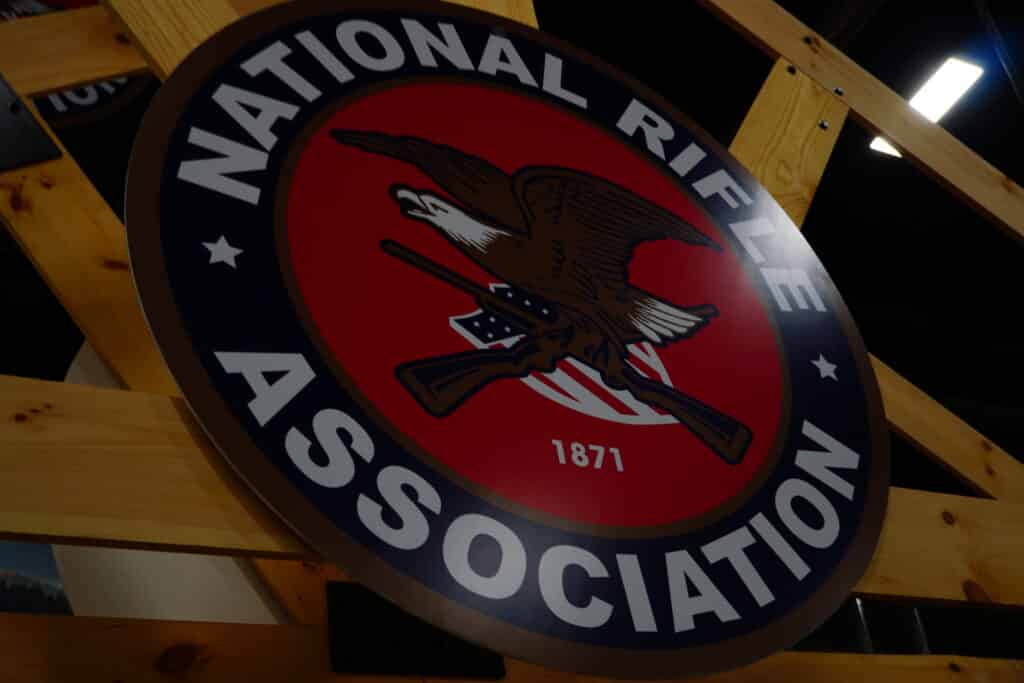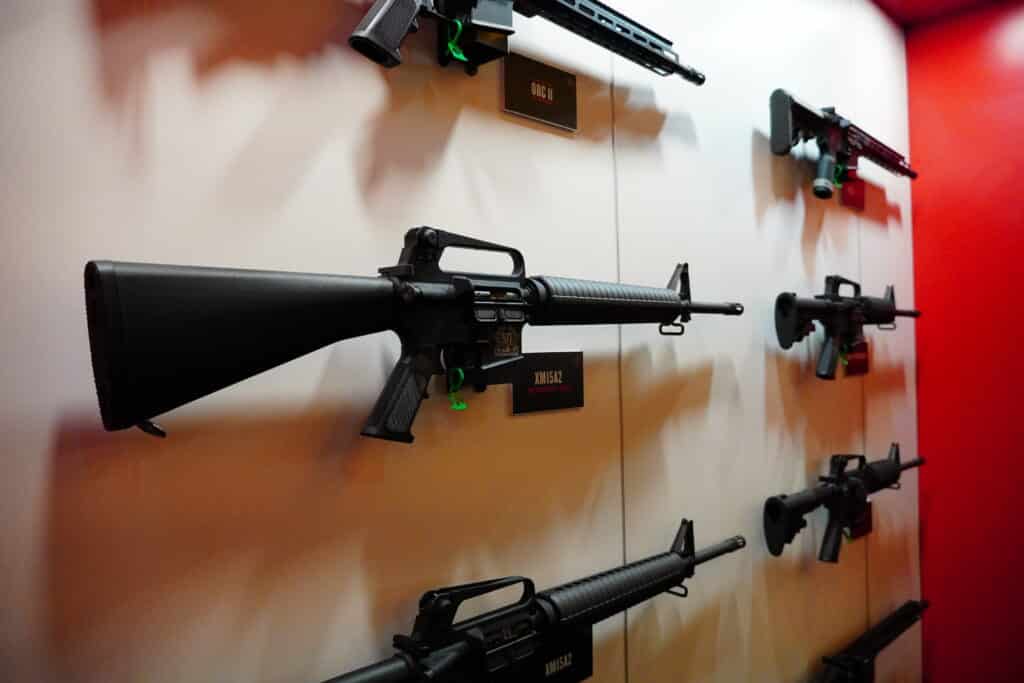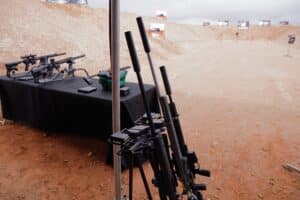As we wait for the jury to deliver its verdict in the NRA’s corruption trial, I think it’s worth asking where the group will go from here. Certainly, the outcome of the case will have influence over that. But how much influence?
There are probably two paths forward based on what the judge and jury do with the case. I take a look at a pair of recent scandals at major non-profits that provide insight into which path might work better.
Plus, on the podcast, I describe my on-the-ground experience at the NRA trial and Trump’s speech to the group in Pennsylvania.
Meanwhile, Contributing Writer Jake Fogleman looks at the recent failure of a rebranded AR-15 ban effort in New Mexico. He examines why the bill went down, and whether it’s down for good.

Analysis: Can the NRA Recover? [Member Exclusive]
By Stephen Gutowski
A jury is currently considering the fate of the charges against the NRA and its top leadership. Whatever they decide, it’s worth asking if the nation’s largest gun-rights group can ever reach its former heights under any outcome.
The NRA, former CEO Wayne LaPierre, and the other defendants offered up their closing arguments while the New York Attorney General’s office tried to counter them on Thursday. Judge Joel Cohen then read out his instructions to the jury on how to decide the dispute on Friday. The six New Yorkers then headed back to deliberate and didn’t return.
They’ll be back at it on Tuesday. It’s possible–perhaps probable–that they will find the NRA and its leadership didn’t properly administer the non-profit’s funds. They may then recommend the judge force LaPierre and the other individual defendants to repay tens of millions to the NRA as well as ban them from working at any non-profit again. After that, the judge could appoint an overseer to scrutinize the NRA’s governing structure and operations.
If that happens, the gun-rights group will undergo what’s likely to be a significant internal makeover. If, instead, the jury sides with the NRA and individual defendants, it will probably continue on with the strategy it has been pursuing since the controversy began.
Either way, it will be a huge challenge for the group to return to where it was before the corruption allegations surfaced. In 2018, before the scandal blew up, the NRA’s Form 990 shows it brought in over $350 million. The group’s revenue has shrunk every year since then and was down to just over $211 million in 2022.
Of course, it’s hard to know exactly what will happen. The NRA has lost millions of members, and it’s not clear how many it has left. Regaining their trust will probably be a taller task for the NRA than other groups who’ve found themselves in at least somewhat similar circumstances.
Most non-profit scandals don’t drag on this long or reach the point of a jury trial. NRA leadership would likely argue that’s because the AG’s political bias has motivated her to take this case further than others, and the AG would probably respond by saying the NRA refused to come into compliance with the law by making necessary reforms.
Whichever view you take, the bottom line is that perfect examples of what might happen to the NRA really don’t exist.
However, some recent high-profile scandals might still be instructive. Two examples provide some particularly interesting insight into the different paths the NRA might take and how that could work out.
In 2012, the Susan G. Komen Foundation became the center of a public relations firestorm after it dropped grants for breast cancer screening exams at Planned Parenthood (before later reversing itself). The decision alienated a substantial portion of the group’s donor base and subjected them to political attacks. It also increased scrutiny of how the organization was run.
The scrutiny led to numerous stories on founder and CEO Nancy Brinker’s lavish spending habits and questionable governing style. Critics questioned her $400,000 salary. They also raised concerns over her expensive travel habits.
Brinker, who had built Komen into a nationally recognized charity, eventually stepped down to make way for new leadership. But that decision took over a year to take effect and came after she received a 64 percent raise that only generated more controversy.
Komen’s Form 990 shows it brought in just under $200 million in 2012. It shrunk fast after that, and it’s never recovered. In 2023, the group brought in just over $100 million.
In January 2016, the Wounded Warrior Project (WWP) came under fire for extravagant parties and luxury accommodations provided to its leadership and staff during retreats paid for by the veterans’ charity. By March, the group decided to fire its top executives. It cleaned the slate and moved forward under entirely new leadership from outside the organization.
The relatively quick action did not prevent tremendous donor backlash. The group’s 2016 990 shows it brought in over $320 million. It fell to about $225 million the next year and stayed under $300 million the next few years. However, the group has been able to recover its revenue. Last year, it brought in over $400 million.
So, what WWP did to respond to its spending controversy seems to have worked in the long term.
The accusations of misappropriation of funds in the NRA’s scandal eclipses the severity and duration of those for either Komen or WWP. Neither of the other groups ended up embroiled in a court case, and both ended up wiping away their leadership in an effort to win back donors.
The gun-rights group has experienced similar declines in membership and revenue to the other embattled charities. And it appears to still be shrinking.
To this point, the NRA has responded in a way closer to Komen than WWP. Given the makeup of current leadership, which includes LaPierre allies who approved the questionable spending that has them in court, it’s unlikely the group will change course if the judge and jury leave them in charge. If they’re ousted, there’s greater potential for the NRA to see a significant–though unpredictable–shift.
Swift and substantial reform appeared to work better for WWP than the slow and plodding path did for Komen.
It has already been five years since allegations that NRA leadership, especially LaPierre, diverted millions upon millions of the group’s funds toward private flights, five-star hotels, and luxury vacations or sweetheart deals with friends or family. The group is still run by largely the same people it was then, with LaPierre remaining in charge until this month and only stepping down of his own accord.
Even under the best-case scenario imaginable for the NRA, it will be challenging to win back the millions that have now abandoned the group. But it’s not an impossible task.

Podcast: The View From the Courtroom as the NRA Corruption Trial Ends [Member Early Access]
By Stephen Gutowski
This week, Contributing Writer Jake Fogleman interviews me about what it was like in the courtroom as New York’s civil trial against the NRA and its leaders reached closing arguments.
Thanks to the support of Reload Members, I’ve been able to cover much of the case from inside the Manhattan court where it’s happening. This is vital because there is no live stream of the proceedings and the transcripts aren’t made available until well after the events of the day, if at all. So, spending the resources to be up there is vital to understanding what is actually happening in a case that will affect the future of the nation’s largest gun-rights group, which has received only modest coverage from major media outlets.
Jake asked me about how the closing arguments went. I did my best to summarize what the NRA, Wayne LaPierre, the group’s top lawyer, and its former treasurer put up as their defense. And how the office of Attorney General Letitia James tried to rebut those arguments.
I did my best to explain, but the answer went on for a while, and I wasn’t able to hit every point. I probably could have talked for another several hours on how the case unfolded over the course of six weeks or even just the closing arguments, which went on for eight hours.
Jake also asked me to predict the outcome of the case based on everything I saw in court. I don’t think it’s possible to predict exactly how the jury will rule on the many, many questions they have to resolve. But I did think significant parts of the jury instructions make an overall win for the NRA, LaPierre, and others very difficult to imagine.
After going over my time at the NRA trial, we discussed my on-the-ground experience during Donald Trump’s speech at the Great American Outdoor Show. The rally took place in Pennsylvania, a key state in what’s looking like an inevitable rematch between Trump and President Joe Biden. But it wasn’t as newsworthy as I’d expected it to be since the NRA didn’t actually announce its endorsement of Trump.
Instead, it was much more akin to a normal Trump rally. Trump made some specific promises about gun policy, but none of them were new.
The lack of an endorsement felt especially odd since the political speech was a new component of the event, and no other politician was invited, including Trump’s remaining Republican opponent, Nikki Haley. And the speech was run like a rally, with the NRA repeatedly heaping praise on Trump and calling for him to be president again.
The rally also featured moments where the crowd was encouraged to yell their shared disdain at the media in the room in what has been a staple of Trump rallies for years but which also fell more ominous after the events of January 6th. The crowd was energetic at points, cheering and laughing at Trump’s now-familiar routine. But they also quieted down through long stretches of his stream-of-consciousness asides and the venue that started nearly full of Trump supporters was about half empty by the time he wrapped up an hour and 15 minutes after he’d arrived.
Plus, I interviewed Jake about what happened to the rebranded effort to ban AR-15s and other guns in New Mexico.
You can listen to the show on your favorite podcasting app or by clicking here. Video of the episode is available on our YouTube channel. Reload Members get access on Sunday, as always. The episode will go public on Monday.

Analysis: First Attempt to Repackage an ‘Assault Weapon’ Ban Falls Flat [Member Exclusive]
By Jake Fogleman
New Mexico’s political leadership opted to take the lead in testing the political waters with a rebranded “assault weapon” ban this session. The results don’t bode well for the strategy moving forward.
As the state’s 30-day legislative session gaveled to a close for the year Thursday, it became clear that the vast majority of Governor Michelle Lujan Grisham’s (D.) ambitious gun-control agenda was doomed to fail. Five of the seven major gun-control policies she prioritized heading into the session ultimately died in the legislature, including her marquis proposal for a revamped ban on AR-15s and other semi-automatic weapons based on novel federal legislation.
Following the defeat of a traditional “assault weapon” ban bill in the state’s 2023 legislative session, Lujan Grisham vowed to continue searching for ways to get a ban across the goal line in future sessions. That’s when a member of her state’s US Senate delegation provided a new source of inspiration.
In partnership with a group of more moderate Senate Democrats, Senator Martin Heinrich (D.) introduced the Gas-Operated Semiautomatic Firearm Exclusion (GOSAFE) Act last November. The bill, which would functionally ban the same weapons as traditional assault weapon legislation, was touted by Heinrich as being “based on the lethality of their internal mechanisms, as opposed to focusing on cosmetic features.” He and his fellow co-sponsors hoped the bill would create a more politically palatable gun ban for lawmakers to vote on.
And while that hasn’t yet proved out at the federal level—the bill continues to languish in the Democratic-controlled Senate—it was enough to convince Lujan Grisham that a New Mexico GOSAFE Act was just what the doctor ordered for getting a gun ban to her desk.
“I’ve got a set of lawmakers that are more likely than not to have a fair debate about guns, gun violence, weapons of war and keeping New Mexicans safe than members of Congress are,” she told the Associated Press heading into the session. “We will have to see how those votes all shake out.”
Those votes, as it turns out, never came. HB 137, the bill carrying the new ban, never made it to the floor of either chamber before the clock ran out on the session. That’s despite other controversial gun bills dealing with waiting periods and new gun-free zones receiving significant debate and ultimately passing. That outcome suggests it will take more than a rebranding exercise to get hesitant lawmakers to swallow a broad ban on commonly owned semi-automatic firearms.
The bill’s failure this session may not be a total indictment on the assault weapon ban rebranding strategy, though. There were other mitigating factors at play this year. After all, it was not the only gun-control bill that failed to gain traction.
The Democratic-controlled New Mexico legislature also failed to advance bills to make it easier to sue gun businesses, raise the minimum age to purchase firearms, expand the state’s “red flag” law, add liability insurance mandates for gun owners, and create gun-free zones at all parks and playgrounds in the state. Additionally, the bills that did pass related to waiting periods and guns near polling places had to be significantly watered down to get enough lawmakers on board.
It’s possible the AR ban’s failure had less to do with its branding and more with a general lack of appetite for controversial gun bills among New Mexico lawmakers this year. The 2024 session was also abbreviated, lasting just 30 days instead of the full 60-day sessions that occur in odd-numbered years. If lawmakers had more time to deliberate, the bill may have stood a stronger chance.
However, the bill’s political drawbacks remain regardless of year or session length. HB 137, much like the federal GOSAFE Act it replicates, would still outlaw a sizeable portion of civilian firearm and magazine offerings, including the most popular type of rifle in the country. Getting lawmakers from conservative and moderate-leaning districts to support that effort is a large hill to climb, no matter what statutory mechanism supporters use to accomplish it.
Furthermore, lawmakers in other states appear to remain unconvinced of the strategy. Colorado, like New Mexico, failed to advance an assault weapon ban in 2023 despite strong Democratic majorities in both chambers of its legislature. And like New Mexico, lawmakers in Colorado are trying again this year to get one passed. Colorado Senator Michael Bennett (D.) is also a co-sponsor of Heinrich’s GOSAFE Act. But instead of attempting to follow the lead of its Senate delegation, Colorado lawmakers simply re-introduced a traditional features-based “assault weapon” ban, as have lawmakers in Minnesota and Rhode Island.
Future legislative sessions will offer more insight into the efficacy and influence of the repackaging strategy. Despite its failure to alter the fate of a semi-auto ban in New Mexico this year, there are signs that it isn’t going away. In a press release celebrating the end of the state’s legislative session, Everytown for Gun Safety praised the GOSAFE Act attempt and pledged to keep fighting for it in future sessions.
“The bills considered included first-in-the-nation legislation, modeled after Senator Heinrich’s federal bill, that would prohibit the sale, transfer, and receipt of gas-operated semi automatic firearms and large-capacity magazines that hold more than 10 rounds of ammunition,” the group wrote. “Moms Demand Action and Students Demand Action volunteers will continue advocating for the measure ahead of the next legislative session.”
Governor Grisham seems unlikely to shy away from the issue either. Over the last year, she has made gun control a significant tenet of her policy agenda, even when it means pursuing policies that earn her rebuke from other gun-control supporters. Grisham also announced that she is currently considering calling for a special session this year to “press for additional public safety protections,” which could include the semi-auto ban.
But even if the state does persist in pursuing the strategy, this session showed that repackaging controversial gun policies is no guarantee that the new presentation will be any more palatable than the old one.
That’s it for now.
I’ll talk to you all again soon.
Thanks,
Stephen Gutowski
Founder
The Reload






